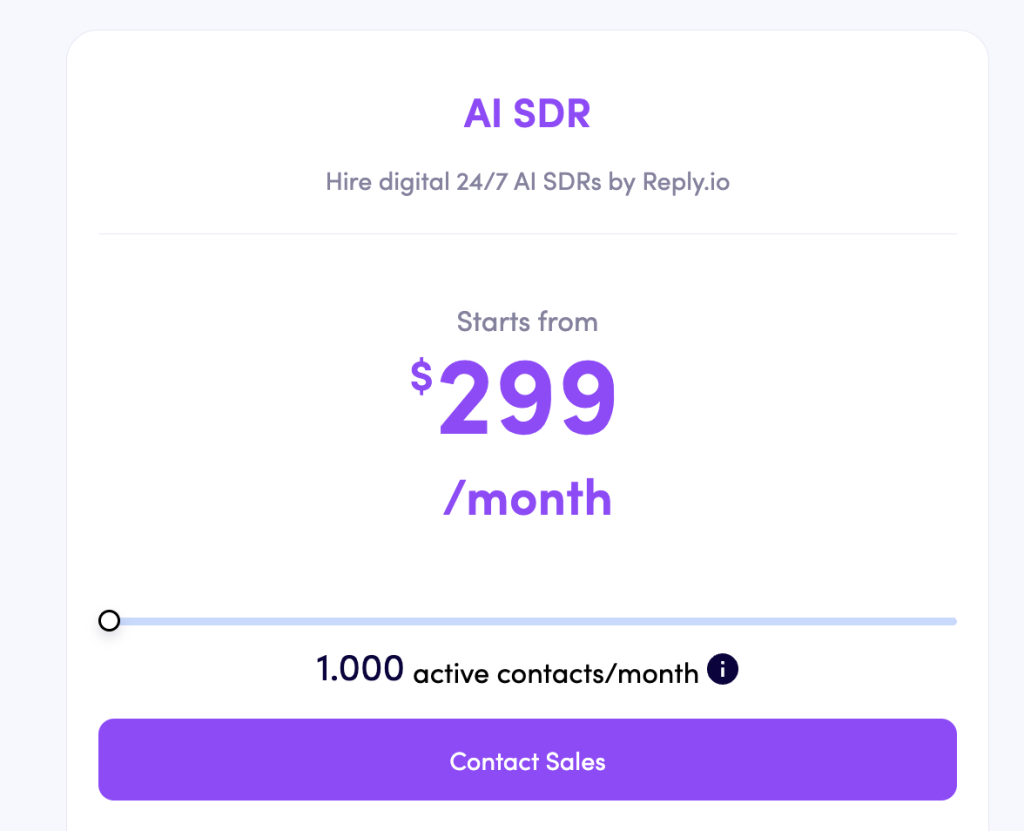Choosing the right outreach platform can feel like quite a task, especially when you are trying to figure out if the price tag makes sense for what you get. So, you might be wondering, how does Reply.io stack up when we talk about its cost? Just like when you compare prices in Tokyo and Singapore, or consider the subtle differences between comparing 'A and B' versus 'A with B,' getting a clear picture of what you pay for with Reply.io is pretty important. We are going to break down their pricing structure, helping you see what each level offers, and who it might be best for, too.
Lots of folks, whether they are small business owners or part of bigger sales teams, really want to find tools that help them connect with people without spending too much money. It's like wanting to test different brands of the same product to see how they work, right? You want to compare 'A and B' on their functionality, or perhaps 'A and B' in terms of their overall worth. We will explore the different Reply.io plans so you can get a good sense of the value each one brings to the table, actually.
This whole idea of looking closely at costs and features is a common one, you know? It is like how my son's English exercise talked about comparing things to find similarities or differences. Here, we are comparing the various Reply.io subscription levels to help you pick the one that fits your needs just right. We will help you see if a particular plan is a good fit for your outreach goals and your budget, too.
Table of Contents
- What's the Deal with Reply.io Pricing?
- Core Factors That Affect the Cost
- The Different Reply.io Plans: A Closer Look
- Making the Right Choice for Your Needs
- Frequently Asked Questions About Reply.io Pricing
What's the Deal with Reply.io Pricing?
When you set out to compare Reply.io pricing, you will find that their approach is pretty common for software that helps with sales and outreach. They usually offer different plans, each with a specific set of features and limits, and these plans come with different price tags. It is a bit like choosing between different models of a car; they all get you places, but some have more bells and whistles than others, and the cost reflects that, in a way.
The main idea behind their pricing is to give you choices that fit where you are in your business journey. A small startup might not need all the advanced tools that a large, established company would, so why pay for them? Reply.io tries to make sure there is an option that works for different team sizes and outreach goals, which is pretty considerate, you know.
You might be asking yourself, "What exactly am I paying for?" Well, it mostly comes down to how many people on your team will use the tool, how many contacts you want to reach out to each month, and which specific features you need. Thinking about these points before you look at the numbers can really help you narrow down your choices, too.
Core Factors That Affect the Cost
When you are trying to figure out the exact cost of Reply.io, there are a few key things that really change the final number. It is not just one flat fee for everyone, which is actually a good thing because it means you can usually find a plan that fits your specific situation. We are going to look at the main elements that play a big part in how much you will pay, so you can get a clearer picture, you know.
How User Seats Influence Your Bill
One of the biggest factors that influences Reply.io pricing is the number of user seats you need. A "user seat" basically means one person on your team who can log into the platform and use its features. If you are a solo entrepreneur, you might only need one seat, which keeps your costs lower, obviously.
However, if you have a sales team of, say, five people, you would need five user seats. Each additional seat typically adds to your monthly or yearly bill. This makes a lot of sense, as more users mean more resources used on Reply.io's side, and it is pretty standard practice for software companies, too.
So, before you even look at the plans, it is a good idea to count how many people on your team will actually be sending out emails or managing campaigns through Reply.io. This number will really shape which plan makes the most sense for you and what your total cost will be, very much so.
Contact Limits and Your Outreach Volume
Another important aspect of Reply.io pricing is the number of contacts you can reach out to within a given period, usually a month. Each plan comes with a set limit on how many unique contacts you can engage with. This is pretty important if you send out a lot of emails or if your campaigns involve reaching a very large audience, in a way.
For example, a basic plan might allow you to contact a few thousand people each month, which is perfectly fine for smaller operations. But if your strategy involves reaching tens of thousands of potential customers, you will need a plan with a much higher contact limit, and that will naturally come with a higher price, so it's almost a given.
It is really worth thinking about your typical outreach volume. Do you send out a few targeted campaigns, or are you constantly engaging with new leads on a massive scale? Your answer here will help you pick a plan that does not limit your growth or force you to upgrade too quickly, which is a good thing to consider, you know.
Feature Sets: What You Get at Each Level
Beyond users and contacts, the specific features included in each plan also play a big role in Reply.io pricing. Lower-cost plans will offer the core functionalities you need for basic outreach, like sending automated email sequences and tracking opens and clicks, basically.
As you move up to more expensive plans, you will gain access to more advanced tools. This could include things like A/B testing for your emails, better reporting and analytics, integrations with other sales tools you might use, or even AI-powered features that help with email writing or lead scoring. These extra features can really make a difference in the effectiveness and efficiency of your campaigns, in some respects.
It is a bit like comparing different versions of a software program; the basic version does the job, but the professional version has all the extra tools that serious users might need. So, think about what features are absolutely essential for your outreach efforts and which ones would be nice to have but are not critical right now. This can help you avoid paying for things you do not really need, which is pretty smart, right?
The Different Reply.io Plans: A Closer Look
Reply.io typically offers a few distinct plans, each designed to cater to different needs and team sizes. Understanding what each plan includes is key to figuring out the best value for your money. We are going to go through them one by one, giving you a general idea of what to expect from each, which is quite helpful, actually.
Starter Plan: For the Lone Ranger
The Starter plan is usually the most budget-friendly option when you compare Reply.io pricing. It is often designed for individuals or very small teams who are just getting started with automated email outreach. You might find it perfect if you are a freelancer, a solo founder, or someone just beginning to experiment with sales automation, so it's almost ideal for that.
This plan typically includes one user seat and a limited number of contacts you can reach each month. It gives you the fundamental tools to send out email sequences, track basic metrics like open rates and reply rates, and manage your contacts. It is a good way to dip your toes in the water without a huge financial commitment, you know.
While it might not have all the bells and whistles of the higher-tier plans, the Starter plan provides a solid foundation for consistent outreach. It is quite suitable for those who need to automate their initial contact efforts but do not have a massive volume of leads to process just yet, which is often the case for new ventures, too.
Professional Plan: Stepping Up Your Game
Moving up the ladder, the Professional plan usually represents a significant step up in terms of both features and capacity. When you compare Reply.io pricing, this plan often hits a sweet spot for growing businesses and small to medium-sized sales teams. It is built for those who need more than just the basics but are not quite ready for enterprise-level solutions, in a way.
This plan typically offers more user seats, allowing several team members to work together on outreach campaigns. The contact limits are also much higher, letting you scale your efforts to a larger audience. You will often find more advanced features here, like A/B testing capabilities, more detailed reporting, and perhaps some integration options with popular CRM systems, very much so.
The Professional plan is a good choice if your team is actively engaged in sales or marketing and needs to run multiple campaigns simultaneously. It provides the tools to optimize your outreach, understand what works best, and manage a larger volume of leads more effectively. It is a solid investment for teams looking to grow their sales pipeline consistently, actually.
Ultimate Plan: For the Big Players
At the top end of Reply.io pricing, you will usually find the Ultimate or Enterprise-level plan. This option is made for larger organizations, big sales departments, or companies with complex outreach needs and high volumes. It is where you get access to everything Reply.io has to offer, and it comes with a price tag that reflects that, obviously.
This plan typically includes a generous number of user seats, sometimes even unlimited, and the highest possible contact limits. You will get all the advanced features, including priority support, dedicated account managers, deeper analytics, custom integrations, and often access to beta features or AI-powered tools that are not available on lower plans. It is pretty comprehensive, you know.
The Ultimate plan is for businesses that are serious about scaling their outreach, need top-tier performance, and have the budget to invest in the best tools available. It is designed to handle high-volume campaigns, provide extensive insights, and offer the most robust support for complex sales operations. If your team is large and your outreach is a core part of your business growth, this plan might be what you need, too.
Making the Right Choice for Your Needs
When you are trying to compare Reply.io pricing and decide which plan is best, it really comes down to a few key questions about your own situation. It is not just about picking the cheapest or most expensive option; it is about finding the right fit for your specific goals and resources, which is pretty important, you know.
First, think about your team size. How many people will actually be using Reply.io day-to-day? If it is just you, a Starter plan might be perfect. If you have a growing team, the Professional plan could be a better fit, allowing everyone to collaborate. For large departments, the Ultimate plan will give everyone the access they need, actually.
Next, consider your outreach volume. How many unique contacts do you plan to reach out to each month? If you are sending a few hundred emails, a basic plan might suffice. But if you are looking at thousands or tens of thousands, you will definitely need a plan with higher contact limits to avoid hitting a ceiling, so it's almost a necessity.
Then, think about the features you absolutely cannot live without. Do you need advanced A/B testing to optimize your emails? Is integration with your CRM a must-have? Or are basic email sequences enough for now? Matching your feature needs with what each plan offers will help you avoid overpaying for tools you do not use, or underpaying and then realizing you are missing something important, in a way.
It is also smart to consider your budget, obviously. While it is good to get the features you need, you also want to make sure the cost aligns with what you can comfortably spend. Sometimes, starting with a lower plan and upgrading later as your needs grow is a very practical approach, too.
Remember, comparing things, whether it is prices in different cities or different versions of a product, helps you make a more informed decision. Just like you would compare 'A and B' on their functionality, take the time to compare the Reply.io plans based on your user count, contact volume, and desired features. This careful look will guide you to the plan that gives you the best value for your specific situation. You can learn more about our main offerings on our site, and if you want a deeper dive into how different tools stack up, you might want to check this detailed guide.
It is worth noting that pricing structures can sometimes change, so it is always a good idea to check the most current information directly from the source. You can usually find the latest details on their official website, like the one here: Reply.io Pricing Page. This ensures you are looking at the most up-to-date numbers and offerings, which is pretty important for making a good choice, very much so.
Frequently Asked Questions About Reply.io Pricing
People often have similar questions when they are trying to figure out the cost of tools like Reply.io. Here are a few common ones, with some straightforward answers to help clear things up, actually.
1. Does Reply.io offer a free trial?
Yes, Reply.io typically offers a free trial period. This is usually a great way to test out the platform and see if it fits your needs before you commit to a paid plan. It lets you get a feel for the features and how easy it is to use, which is pretty helpful, you know.
2. Can I change my Reply.io plan later?
Most software services, including Reply.io, allow you to upgrade or downgrade your plan as your needs change. If your team grows or your outreach volume increases, you can usually move to a higher-tier plan. If you find you are not using all the features or need less capacity, you might be able to move to a lower plan, too.
3. Are there any hidden fees with Reply.io pricing?
Generally, reputable software companies like Reply.io are pretty transparent about their pricing. The listed prices usually cover what is included in each plan. However, it is always a good idea to read the terms and conditions or ask their sales team if you have any specific questions about potential extra charges for things like exceeding contact limits or needing special integrations. Clarity is key, in a way.



Detail Author:
- Name : Alexandrea Becker
- Username : durgan.jerrold
- Email : zemlak.carol@miller.com
- Birthdate : 2001-08-02
- Address : 56562 Cassidy Drive Apt. 860 Port Norrisshire, OR 82013
- Phone : +1-423-213-8889
- Company : Oberbrunner Group
- Job : Nuclear Technician
- Bio : Iusto culpa cum expedita veniam dignissimos corporis dolorem. Eius sed doloremque et atque optio repellendus soluta. Sed tenetur et non vitae dicta sit et. Neque voluptatem ex error possimus sunt.
Socials
facebook:
- url : https://facebook.com/rwalter
- username : rwalter
- bio : Dolore laudantium totam non eaque cupiditate aliquid facere.
- followers : 5900
- following : 198
linkedin:
- url : https://linkedin.com/in/walter1976
- username : walter1976
- bio : Hic ad blanditiis libero omnis odio neque.
- followers : 3884
- following : 2653
twitter:
- url : https://twitter.com/rosella_walter
- username : rosella_walter
- bio : Qui atque repellat dolor voluptas vel quia. Provident qui sapiente esse. Rerum nulla ipsa culpa vero porro sunt.
- followers : 2773
- following : 1100
tiktok:
- url : https://tiktok.com/@walter2013
- username : walter2013
- bio : Et et dicta odit. Aut nihil quam molestias cumque sunt.
- followers : 5521
- following : 1204
instagram:
- url : https://instagram.com/rosella_walter
- username : rosella_walter
- bio : Sapiente rem sit voluptatem cumque et consectetur blanditiis. Voluptatum qui odio voluptatem illo.
- followers : 496
- following : 1119